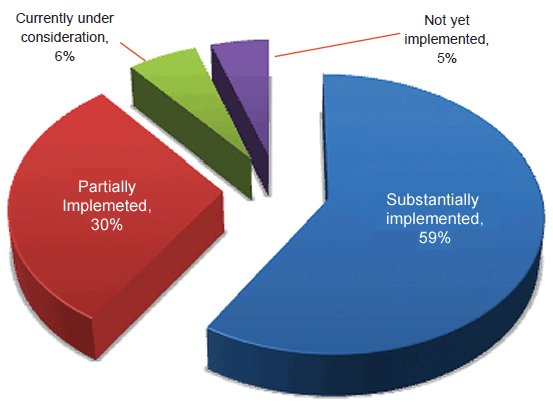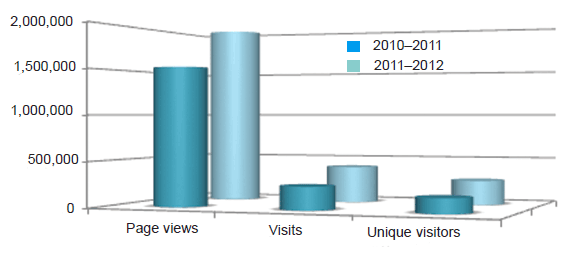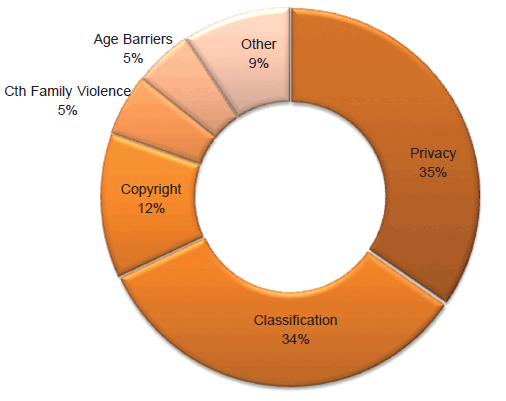15.10.2012
The ALRC measures the success of Program 1 in delivering its outcome through the following key performance indicators:
- implementation of ALRC reports by government and other bodies, substantially or partially, over time;
- the number of citations or references to ALRC reports and recommendations in parliamentary debates, in court citations and decisions, and in academic publications and other publications;
- the number of submissions to each inquiry;
- the number of visitors to the website;
- the number of presentations and speaking engagements about ALRC inquiries;
- the number of media mentions of the ALRC and its work.
|
Program 1 |
Target |
Actual |
|---|---|---|
|
Implementation of reports—substantially or partially implemented |
85% |
89% |
|
Citations and mentions |
45 |
76 |
|
Submissions received |
80 |
2,470 |
|
Visitors to website |
>200,000 |
324,724 |
|
Presentations and speaking engagements |
20 |
27 |
|
Media mentions |
200 |
419 |
Implementation of reports
The ALRC has no direct role in implementing its recommendations. As there is no statutory requirement for the Australian Government to respond formally to ALRC reports, the ALRC monitors major developments in relation to issues covered in its past reports, and assesses the level of implementation that those reports have achieved. It is not uncommon for implementation to occur some years after the completion of a report.
The ALRC considers that a report is substantially implemented when the majority of the report’s key recommendations, have been implemented by those to whom the recommendations are directed. Partial implementation refers to implementation of at least some recommendations of an ALRC report. The ALRC takes a conservative approach when considering whether a report should be characterised as having been ‘partially’ or ‘substantially’ implemented. The term ‘under consideration’ applies to reports that have received a positive response from those to whom the recommendations are directed, but are still awaiting implementation, and to those that have been completed within the past two years and are yet to receive a formal response.
Legislative and other implementation activity in 2011–12, as described in Appendix F, has altered the levels of implementation of all ALRC reports with the following results:
- 59% are substantially implemented;
- 30% are partially implemented;
- 6% without any implementation to date were currently under consideration; and
- 5% had not been implemented.
These figures represent a fractional decrease in the implementation rate of ALRC reports to 89%, from 90% in 2010–11. The government has yet to respond to a number of recently completed ALRC reports, including Making Inquiries: A New Statutory Framework (ALRC Report 111, 2010), Secrecy Laws and Open Government (ALRC Report 112, 2010) and Classification—Content Regulation and Convergent Media (ALRC Report 118, 2012).
Implementation status of ALRC reports as at 30 June 2012

Appendix F provides a detailed update on action in relation to ALRC reports during 2011–12.
Appendix G provides a brief overview of the implementation status of all 81 reference-related ALRC reports. For a list of these reports, see Appendix L.
Court citations
Past ALRC reports are cited by Australian courts and tribunals as well as in numerous academic articles and other publications. During 2011–2012, there were more than 70 mentions of ALRC reports within the judgments of major Australian courts and tribunals.
These included three from the High Court of Australia, 21 from the Federal Court of Australia, and 38 from state and territory Supreme Courts or Courts of Appeal, as well as decisions of other major courts and tribunals, such as the Family Court of Australia and the Land and Environment Court.
This total number of 76 represents an increase of 4% in the number of judgments from major Australian courts referring to ALRC reports when compared with 2010–11.
One point of interest is that the ALRC report most often cited across the Australian courts continues to be Evidence (Interim) (ALRC Report 26, 1985) as it assists the judiciary by informing them of the background of the Evidence Act 1995 and state and territory uniform Evidence Acts.
A list of these court citations is provided at Appendix H.
Submissions
The number of submissions received by the ALRC is a measure of public engagement with its work and the extent to which the consultation papers have stimulated debate and discussion. However, the number of submissions received for any inquiry is also influenced by its subject matter—particular inquiries are likely to generate a greater, broader degree of public interest and participation than others.
|
Consultation paper |
Submissions closing date |
Submissions received |
|---|---|---|
|
Censorship and Classification—issues paper |
15 July 2011 |
2,253 |
|
Family Violence and Commonwealth Laws—discussion paper |
30 September 2011 |
84 |
|
Censorship and Classification—discussion paper |
18 November 2011 |
78
|
|
Age Barriers to Work—issues paper |
14 June 2012 |
55 |
|
Total submissions received |
|
2,470 |
Online communications
ALRC website
Since its re-design and development in 2010, the ALRC website has become a pivotal communication tool for the ALRC and a law reform resource for the wider public. The ALRC strives to continually build value into the website, both in terms of providing useful and accessible content relevant to stakeholders and researchers, and utilising its functionality as an online consultation tool.
Key metrics for 2011–12:
- visits = 489,558
- page views = 2,463,691
- unique visitors = 324,724
2011–12 is the first full 12-month reporting period since the launch of the ‘new’ ALRC website in late August 2010. Comparing the statistics for eight months (August–June) in both reporting periods:
- visits have increased by 61%
- page views have increased by 30%
- unique visitors have increased by 65%
Comparison of website traffic: August–June in 2010–11 and 2011–12

During the reporting period the ALRC commissioned Vision Australia to review the ALRC website against the Web Accessibility Initiative Web Content Accessibility Guidelines version 2.0 (WAI WCAG 2.0) and is working towards meeting Level AA by September 2012. The National Transition Strategy requires all Australian Government websites to meet Level A by December 2012, and Level AA by December 2014.
E-news
During the reporting period the ALRC published regular e-newsletters for each of its current inquiries, as well as the ALRC Brief (published 3–4 times a year). E-newsletters are distributed to subscribers who opt in via an online form or by direct request.
|
Inquiry |
Subscribers |
Issues to date |
|---|---|---|
|
Copyright and the Digital Economy |
478 |
2 |
|
Age Barriers |
174 |
5 |
|
Censorship and Classification |
413 |
10 |
|
Commonwealth Laws and Family Violence |
399 |
12 |
|
ALRC Brief |
352 |
5 |
Online forums
For the Censorship and Classification inquiry, the ALRC ran two online discussion forums on its own website, at different stages of the inquiry. This represented a new strategy for the ALRC. The two forums attracted 200 comments from 32 participants, some of which were quoted in the discussion paper and report.
 Twitter
Twitter
The ALRC’s Twiiter handle is @AusLawReform. The ALRC’s following on Twitter has grown substantially in the reporting period, from 1,820 to 3,844 followers. This level of growth is partly accounted for by the broad public interest in the Classification and Copyright inquiries.
Twitter users are also able to follow conversations about a particular inquiry, without actually following the ALRC, by using the dedicated hashtags used for each inquiry, for example, #clasrev (Classification) and #copyrev (Copyright).
 Facebook
Facebook
The Classification and Copyright inquiries, alongside the broad level of public interest they command, also have in common large numbers of internet-savvy stakeholders, comfortable aggregating their news, and engaging in discussion, via social media. To increase exposure of the ALRC’s work in these areas, a Facebook page was created for each inquiry. The Classification inquiry Facebook page had been ‘liked’ by 145 people at the close of the inquiry (and the closure of the page). The Copyright Facebook page has, to date, 126 likes.
 YouTube
YouTube
In 2005, the ALRC celebrated its 30th anniversary. To commemorate this milestone, past Presidents, Commissioners and friends of the ALRC were asked to share their perspectives on the history and achievements of one of Australia’s most influential law reform bodies. The result was ‘30 years of law reform—the movie’. Previously trapped in DVD format, the ALRC has converted this document into mp4 format and made it available to all via YouTube (complete with transcript). This marks the ALRC’s first entry in this space.
Presentations and speaking engagements
Presenting at public conferences, seminars and parliamentary inquiries ensures that the work of the ALRC is publicly debated and discussed. During 2011–12, ALRC Commissioners and staff made 27 presentations at a range of events around the country. They also contributed 15 articles to a range of journals and publications. A full list of presentations and articles is at Appendix I.
Public debate and media interest
The ALRC actively promotes public debate on issues raised by its current and past inquiries, and on law reform generally. The ALRC conducts its own media monitoring, using a variety of tools and resources.
This media log is provided at Appendix J. Please note that not all media mentions are included in the media log. It includes only those media mentions that are online and are not behind a pay wall.
During 2011–12, the ALRC identified 419 mentions of its work across a range of online and traditional media. This represents an increase of approximately 30% from the previous year.
Reflecting the broad community concern about privacy issues and ongoing debate in the area, the majority of media mentions (35%) referred to the ALRC 2006–2008 inquiry about privacy law reform and the recommendations in the report, For Your Information: Australian Privacy Law and Practice. The ALRC’s work on privacy has dominated media attention given to the ALRC’s work each year since For Your Information was first published in 2008.
Of recent and current inquiries, the Classification inquiry received the lion’s share (34%) of attention. The high level of media and public interest was borne out in the high number of submissions received for the inquiry (see Submissions, page 32). The Copyright inquiry is steadily gaining ground, attracting a 12% share within a very short period (Terms of Reference were only received in June 2012).
Media mentions per inquiry 2011–12

Participation in external inquiries
Often through its inquiry work the ALRC has already conducted valuable research into areas of law or legal processes that become subject to review by other agencies or parliamentary committees. Where appropriate and relevant, the ALRC provides briefings or written submissions to parliamentary committees, ministers, government departments, and other bodies. In this way, the experience and knowledge the ALRC develops during inquiries is shared for the benefit of the Australian community.
The ALRC is guided by a protocol that outlines when it is appropriate for the ALRC to give a briefing or to make an external submission. The considerations include:
-
the consonance of issues raised in the review or inquiry being undertaken by the external body with issues covered in current inquiry work or past reference work of the ALRC;
-
the consonance of issues raised in the review or inquiry being undertaken by the body and the expertise and knowledge of current Commissioners and staff members; and
-
the availability of, and impact upon, ALRC resources.
Where appropriate, submissions are made available on the ALRC website.
During the reporting period, the ALRC made five written submissions drawing on past inquiries. See Appendix K.
